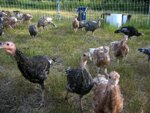“Notes from the Field”- Raising Heritage Turkeys With the Help of SARE
December 1st, 2008
Jacob Cowgill is a young farmer from Montana. He has spent the past two seasons experimenting with dryland vegetable production in north-central Montana. He and his new bride are planning to start their own farm very soon. For more information about the Sustainable Agriculture Research and Education (SARE) program, visit the SARE website.
A couple Saturdays ago, I placed the final heritage turkey in the chill tank and felt a sense of relief. The season was finally over. The wheat, sunflowers, and other field crops were harvested long ago, and the potatoes put in the root cellar at the end of October, but my flock of heritage turkeys lived on, through hard freezes, high winds, and snow flurries. They had arrived in the mail on May 1 and for the next 7 months, my days revolved around taking care of them. I had heard a little bit about heritage turkeys last winter and decided I wanted to try my hand at raising them. Starting without any feeders, waterers, a fence and shelter, and most importantly start-up capital, I looked around for some sort of funding and I found Western SARE. I applied for and received a grant to raise my heritage turkeys on pasture. It was with this support from SARE, I was able to explore the viability of raising turkeys within an organic dryland farming system.
More than anything, the SARE grant gave me the chance to experiment in something nobody else in the area was doing. No information exists for which turkey breeds are appropriate for north-central Montana or what sort of shelter will survive the high winds and heavy November snows while protecting the flock. In a way, the grant allowed me to be an independent researcher, a private extension agent (and one who has already fielded numerous questions from interested farmers).
Most farmers I know are highly-intelligent and creative people. But since day-to-day farming is already a risky venture, many aren’t willing to go out on a limb to try something new. If agencies aren’t experimenting with sustainable systems, its unlikely farmers will. Grants such as these stimulate innovation on the farm level and provide producers with the guide to create a plan and the support for them to follow through with their ideas. With each successful project, the producer then becomes somewhat of an expert and a resource for others willing tackle an unconventional project. While I certainly don’t consider myself an expert on raising turkeys, now I have enough experience under my belt to do it again next year.
Related posts:

One Response to ““Notes from the Field”- Raising Heritage Turkeys With the Help of SARE”
1Connie Hansen
December 6th, 2008 @ 2:59 pm
Two years in a row now we have been able to purchase heritage turkeys for the holidays. Last year we transported said turkey to S. D. for Thanksgiving. This year’s bird traveled with us to Tuscon,Arizona and provided dinner for 6 couples who had never eaten any turkey except the the “white, pop-up variety”. The roasted turkey brought rave reviews from all assembled and we definitely didn’t fuss over fixing him.
Keep up the good work and pass the word!
Leave a Reply